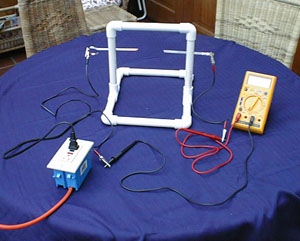
Ground Fault Interupt box powering a hot dog cooker.
Click image to enlarge.
with ground fault interupt
by Don Rathjen

Ground Fault Interupt box powering a hot dog cooker.
Click image to enlarge.
HOT DOG
Cook a hot dog by passing electric current directly through the hot dog, using a device similar to the one shown in the photo. The actual configuration of the stand is not critical, as long as the hot dog completes the circuit and there are no short circuits or safety problems. (CAUTION: This procedure uses 120 volt ac, and is POTENTIALLY LETHAL. It is strongly recommended that you use the GFCI box in the circuit as shown. Even with the GFCI box as protection, you should NOT TOUCH THE HOT DOG OR ANY EXPOSED CONTACTS WITHOUT FIRST UNPLUGGING the cooker circuit from the GFCI box. THIS ACTIVITY SHOULD BE DONE ONLY AS A TEACHER DEMONSTRATION, AND NOT AS A STUDENT LAB. STUDENTS SHOULD STAY A SAFE DISTANCE AWAY AT ALL TIMES.
The ac meter will start out with very low readings, and should gradually increase to between one and two amps. As this occurs steam will be emitted, first near the contact points at the ends and then at various places over the length of the hot dog. It takes between one and two minutes to heat the hot dog thoroughly. Often the process has an "automatic shutoff" caused by buildup of charred meat around the contacts, raising the resistance and thus simultaneously lowering the current. If the average current is 1 amp, then from Ohm's Law (R = V/I) the average resistance is 120v/1 amp = 120 ohms. If you want to extend this a little, you can compare various brands of hot dogs (or hot dogs with different ingredients, e.g. turkey, all beef, etc.), and you can take current readings every 10 seconds and graph current vs. time and/or resistance vs. time. You can also research the cooking process to try and determine what's responsible for the behavior of the resistance during the cooking process (e.g., role of water and "salt" in the conducting process; different "salts" in a hot dog; chemical change during cooking, and its effect on resistance; etc.) When the hot dog is cooked, you can add a little showmanship by getting an apron and/or chef's hat, and making a production of cutting up the hot dog and serving the pieces to your students. I use a huge knife to cut it into small slices, and I do a Julia Childs voice imitation describing the "presentation" as I do it. (I recommend cutting off the charred ends and discarding them.) "Of course" (with French accent) I serve the hot dog with Grey Poupon mustard (optional, as a dip). Commercial versions of this primitive laboratory hot dog cooker were a fad item back around the 60's or 70's, but those remaining have been largely relegated to the back portions of kitchen cabinets or to thrift shops. You may be able to get hold of one by asking students to look at home (I got mine from a student who brought it in on his own, without my even asking) or by checking out thrift shops. These things usually cook multiple hot dogs at once, so are good for a class feast if you're into that, but they're also good for showing a commercial version of a lab prototype.
PICKLE
Use the same apparatus, but use a pickle instead of the hot dog. After a short time, one end of the pickle will suddenly glow brilliant orange as arcing occurs in the sodium-rich brine environment at the electrode.
Acknowledgment
Thanks to my good friend Raleigh Ellisen, from whom I first learned about the hot dog a "few" years ago.
Don Rathjen
Exploratorium Teacher Institute.....3601 Lyon St......San Francisco, CA 94123.....415-561-0313
donr@exploratorium.edu